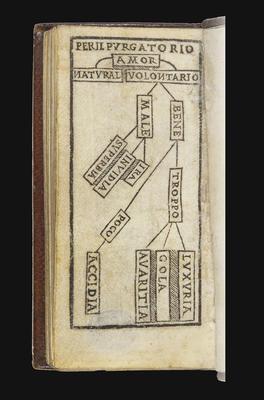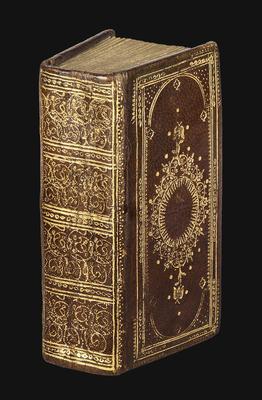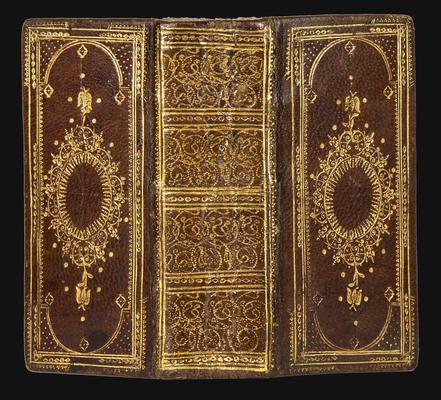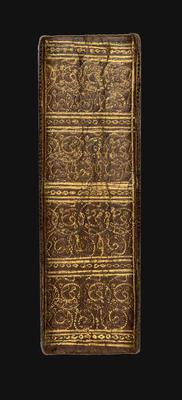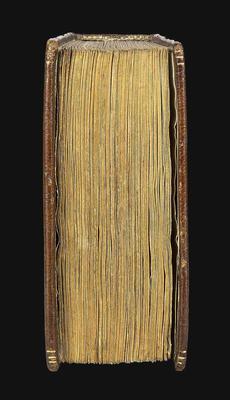Dante Alighieri
Dante col sito, et forma dell’Inferno.
[Venice, Alessandro Paganini, ca. 1516].24° (99x47 mm). Printed on vellum. Collation: A-X8, AA-DD8, EE4.cc ii, [2] leaves. Italic and gothic type. Blank spaces for capitals at the beginning of each cantica. One double-page woodcut plan of Hell (fols. EE2v-EE3r) woodcut diagrams of categories of sins punished in Hell (fols. EE3v-EE4r), and in Purgatory (fol. EE4v). Roman red morocco binding from the late sixteenth century, covers gilt tooled and framed in a border of fillets, with a centre fleuron. Smooth spine, richly decorated in gilt. Gilt edges. A very fine copy.
Provenance: on fol. A1v ownership inscription erased and partly readable under UV lamp ‘henrico' (?); ‘f.H' (monogram on the front pastedown in red ink, repeated in the variant form ‘H.F.' on the rear pastedown); Guglielmo Libri (1803-1869; Catalogue de la Bibliothèque de M L****, Paris 1847, lot 582; sold for 1110 francs); Seymour Kirkup (1788-1880; ownership inscription on the front pastedown ‘Seymour Stocker Kirkup'; Catalogue of the Celebrated Library of Baron Seymour Kirkup at Florence, Dec. 6, 1871, London 1871, lot 1189); purchased by the London bookseller Thomas Boone for £30; Charles Fairfax Murray (1849-1919; A List of Printed Books in the Library of Charles Fairfax Murray, [London] 1907, p. 71, “Dante col sito, et forma dell'Inferno.s.n. [Paganino, s.a.] 32mo. Printed onVellum. old red mor.”); Livio Ambrogio collection.
The exceedingly rare Paganini edition of the Commedia, the first in 24° format, and the only known copy printed on vellum, in the scarcest state with all leaves numbered in roman. It is the smallest Commedia of the Renaissance, known as the Dantino, published in the compact ‘long 24mo' format invented by Alessandro Paganini. This edition was dedicated by him to cardinal Giulio de' Medici, later Clementvii. The volume is part of the series begun by Paganini in the same year, which opens with Petrarch's Rime, Bembo's Asolani, and Sannazaro's Arcadia, all dedicated by the printer to pre-eminent contemporaries and patrons, such as Isabella d'Este.
The printing on vellum indicates that this copy was destined for a very distinguished recipient. It has not been possible to discover the identity of its earliest owner, but its subsequent provenance has also been highly distinguished. It has passed through the hands of some of the most famous book collectors and bibliophiles of the nineteenth and early twentieth centuries, allowing us to trace a fascinating itinerary in the history of Dante collecting. In the first half of the nineteenth century the small volume can be traced back to the collection assembled by the well-known bibliophile (or bibliomane) Guglielmo Libri, and in the 1847 sale catalogue of his library the copy is described as a “précieux exemplaire imprimé sur peau vélin d'une édition rare [...] la reliure de ce petitbijou [...] a du être exécutée en Italie au XVIe siècle; elle est aussi bien conservée que l'intérieur du volume”. The extraordinary features of this Dantino caught the attention of collectors, and it was sold for the very high sum of 1110 francs, almost the same price paid in the same sale for a beautiful and complete copy of the Foligno edition of the Commedia (lot 577, sold for 1325 francs). This ‘small jewel' came into the possession of one of the greatest Dante collectors of the age, the English painter Seymour Kirkup, who – like many other English artists and intellectuals of the time – spent several years in Florence and is wellknown for having discovered in 1840 Giotto's portrait of Dante in the Bargello. His vast collection was sold in 1871 by Sotheby's, and the Dantino was purchased for £30 – by far the highest price in that sale for printed books – by the London bookseller Thomas Boone. The copy later belonged to the library of the artist, dealer and great art collector Charles Fairfax Murray, friend of William Morris, the Rossettis and John Ruskin.


